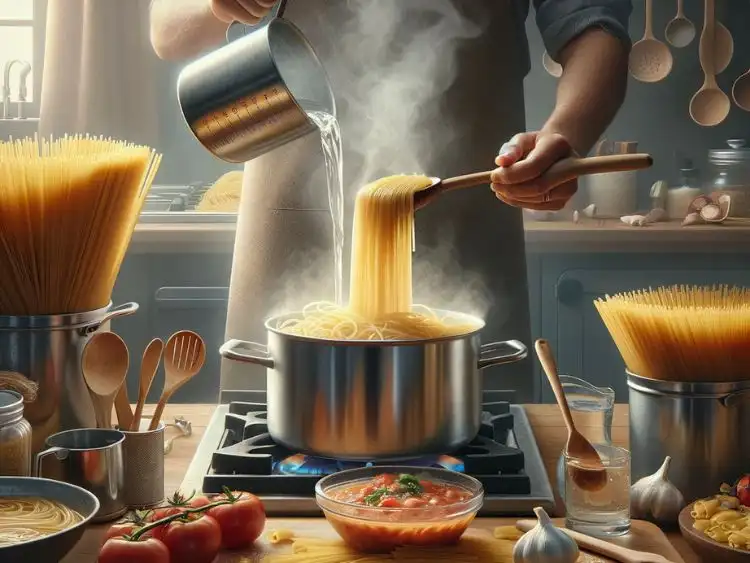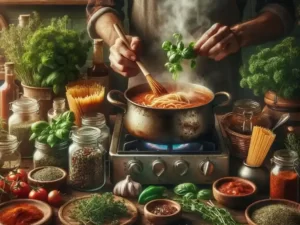Spaghetti, a staple in many households, often serves as a quick, comforting meal. However, the simplicity of spaghetti can sometimes lead to a lackluster dining experience. The key to transforming this basic dish into a culinary delight lies in enhancing its flavor. This introduction delves into the art of elevating spaghetti, ensuring that each bite is a testament to both tradition and creativity.
The journey to flavorful spaghetti begins with understanding its core components. At its heart, spaghetti is a harmonious blend of pasta and sauce, each element holding potential for flavor enhancement. The pasta, often a canvas, absorbs and complements the sauce, which is the essence of the dish. The sauce’s flavor profile can range from rich and hearty to light and zesty, influenced by ingredients and cooking techniques.
One common challenge in spaghetti preparation is achieving a balance of flavors. A sauce that is too bland or overpowering can overshadow the pasta, disrupting the dish’s overall harmony. The secret to a well-balanced spaghetti dish lies in layering flavors and textures. This involves selecting quality ingredients and employing techniques that enrich the sauce’s depth and complexity.
Enhancing spaghetti flavor is not just about adding more ingredients; it’s about understanding how different components interact. It involves a play of acidity, sweetness, and umami, each contributing to a well-rounded taste. Fresh herbs, spices, and the right choice of proteins can elevate the dish from ordinary to extraordinary.
Moreover, the process of flavor enhancement is not confined to the sauce alone. The pasta, often overlooked, plays a crucial role. Cooking it to the perfect al dente texture and utilizing the pasta water can significantly impact the dish’s final taste.
Choosing the Right Base Sauce
The foundation of any great spaghetti dish is its sauce. Selecting the right base sauce is crucial, as it sets the tone for the entire meal. This section focuses on guiding you through the process of choosing a sauce that not only complements your spaghetti but also elevates its overall flavor.
When browsing the aisles for a jar of pasta sauce, the variety can be overwhelming. However, the key to a good choice lies in reading the ingredient list. A high-quality sauce should list whole tomatoes as its first ingredient. This indicates a focus on natural flavors rather than artificial additives. Avoid sauces with added sugars or excessive preservatives, as these can overpower the natural taste of the tomatoes and herbs.
Another aspect to consider is the type of sauce. Marinara, with its simple yet robust flavor, is a popular choice for spaghetti. It offers a balance of tomatoes, garlic, and herbs, providing a classic taste. For a richer, more complex flavor, consider a tomato basil or arrabbiata sauce. These variations introduce additional layers of taste, such as the sweetness of basil or the heat of red pepper flakes.
The texture of the sauce is also important. A chunkier sauce will add a rustic feel to your dish, while a smoother sauce might be preferable for a more refined presentation. This choice depends on personal preference and the desired outcome of your dish.
For those looking to customize their sauce, starting with a basic marinara and adding fresh ingredients can be a rewarding approach. This allows for personalization of the flavor profile, whether you’re aiming for something spicier, sweeter, or more herbaceous.
Related: Spaghetti Seasoning: Enhance Your Dishes With Flavorful Blends
Enhancing with Fresh Ingredients
Elevating the flavor of spaghetti sauce transcends beyond the choice of a base sauce; it involves the infusion of fresh ingredients. Fresh vegetables and herbs not only enhance the taste but also add a nutritional boost to the dish. This section explores how incorporating fresh ingredients can transform a simple spaghetti sauce into a gourmet experience.
Starting with vegetables, onions and garlic are fundamental. Sautéing diced onions until they are translucent brings out their natural sweetness, providing a flavorful foundation for the sauce. Garlic, a versatile and aromatic ingredient, adds depth. Whether minced or roasted, garlic infuses the sauce with a rich, savory flavor that is unmistakable.
Tomatoes, the heart of any traditional spaghetti sauce, can be elevated by using fresh varieties. Adding freshly diced tomatoes to the sauce introduces a bright, tangy element. For a more textured sauce, consider incorporating cherry or grape tomatoes, which burst with flavor and add a pleasant visual appeal to the dish.
Bell peppers and carrots are excellent for adding complexity and sweetness. Sautéed until soft, they blend seamlessly into the sauce, enriching its overall taste profile. These vegetables not only contribute flavor but also enhance the sauce’s nutritional value.
Herbs play a crucial role in flavor enhancement. Basil, with its sweet and peppery notes, is a classic pairing with tomato-based sauces. Fresh parsley adds a mild, herby freshness, while oregano contributes a slightly bitter, earthy flavor. These herbs, used judiciously, can elevate the sauce from ordinary to extraordinary.
Incorporating fresh greens like spinach or kale can introduce a subtle, earthy flavor and additional nutrients. These greens wilt beautifully into the sauce, adding color and texture.
Utilizing Herbs and Spices
The strategic use of herbs and spices is pivotal in transforming a simple spaghetti dish into a flavor-packed culinary creation. This section delves into how the judicious selection and combination of these aromatic ingredients can significantly enhance the taste and aroma of your spaghetti sauce.
Herbs, both fresh and dried, are essential in Italian cooking, and their role in spaghetti sauce cannot be overstated. Basil, known for its sweet and slightly peppery flavor, is a classic choice. It infuses the sauce with a freshness that is quintessentially Italian. Oregano adds a touch of earthiness and a hint of bitterness, complementing the tomato base beautifully. For a more subtle flavor, parsley, with its light and fresh taste, can be stirred in towards the end of cooking to retain its vibrant color and delicate flavor.
Thyme and rosemary, while less traditional in spaghetti sauces, can be used to introduce a new dimension of flavor. Thyme offers a subtle, earthy undertone, while rosemary provides a woody aroma and a slightly lemony taste. These herbs should be used sparingly to avoid overpowering the sauce.
Spices play an equally important role. Red pepper flakes are a simple way to add heat, creating a more dynamic flavor profile. For a hint of sweetness and warmth, a pinch of nutmeg or cinnamon can be surprisingly effective, especially in richer, meat-based sauces.
Italian seasoning, a blend of classic herbs like basil, oregano, rosemary, and thyme, is a convenient option for those looking to simplify their spice use. This blend offers a balanced mix of flavors that are harmonious with tomato-based sauces.
Incorporating herbs and spices into spaghetti sauce is not just about adding flavor; it’s about creating a sensory experience. The aroma of herbs simmering in sauce can transform the kitchen atmosphere, making the cooking process as enjoyable as the eating.
Adding Meat and Protein
Incorporating meat and protein into spaghetti sauce not only enhances its flavor but also contributes to a more satisfying and hearty meal. This section explores various options for adding meat and protein to spaghetti, catering to a range of dietary preferences and tastes.
Ground beef is a classic choice for a traditional meat sauce. Its rich flavor and texture blend seamlessly with tomato-based sauces, creating a robust and fulfilling dish. For a healthier alternative, ground turkey offers a lighter taste while still providing the satisfying feel of a meat sauce. When browning the meat, consider adding a pinch of salt and some Italian herbs to infuse the meat with additional flavor.
Italian sausage is another popular addition. Its distinct blend of spices, including fennel and garlic, adds depth and a slight kick to the sauce. For a more nuanced flavor, mix sweet and spicy varieties of sausage. Brown the sausage pieces in a pan before adding them to the sauce to enhance their flavor and ensure a pleasant texture.
For those seeking plant-based options, there are numerous alternatives that can mimic the texture and heartiness of meat. Lentils, when cooked and seasoned well, can be a fantastic meat substitute in spaghetti sauce. They absorb flavors beautifully and add a nutritious boost to the dish. Plant-based meat substitutes, now widely available, can also be used as a direct replacement for ground meat, offering a similar texture and protein content.
Meatballs, whether homemade or store-bought, are a timeless addition to spaghetti. They can be made from beef, turkey, chicken, or plant-based ingredients. When using frozen meatballs, simmering them in the sauce allows them to absorb the flavors and become more tender.
The Role of Acidity and Dairy
Balancing the flavors in spaghetti sauce is an art, and two key components in this culinary balancing act are acidity and dairy. These elements play pivotal roles in enhancing and rounding out the flavors of the sauce. This section explores how the careful addition of acidic ingredients and dairy products can elevate the taste and texture of spaghetti sauce.
Acidity, when used correctly, can cut through the richness of the sauce, adding a bright and lively dimension to the dish. A splash of red wine vinegar or lemon juice can work wonders in enhancing the natural flavors of the tomatoes. Balsamic vinegar, with its sweet and tangy profile, can add a complex layer of flavor, especially in richer, meat-based sauces. Even a handful of capers or chopped olives can introduce a subtle acidity that enhances the overall taste.
The addition of dairy products to spaghetti sauce introduces a creamy texture and a rich, smooth flavor. A pat of butter, melted into the sauce towards the end of cooking, can add a luxurious silkiness and help to mellow out the acidity and spice. For a more pronounced creamy texture, a dollop of ricotta or cream cheese can be stirred in, creating a velvety and indulgent sauce. Parmesan cheese, a staple in Italian cuisine, adds a salty, nutty flavor when grated over the finished dish or melted into the sauce.
Greek yogurt or goat cheese are less traditional but equally effective options for adding creaminess and a slight tang to the sauce. These should be added at the end of cooking to prevent curdling and to maintain their fresh flavors.
The Secret of Pasta Water
One of the most underutilized ingredients in pasta cooking is the water in which the pasta is boiled. Often overlooked and discarded, pasta water holds the secret to elevating the texture and flavor of spaghetti dishes. This section highlights the importance of pasta water and how to effectively use it in spaghetti preparation.
Pasta water is rich in starches released from the pasta during boiling. This starchy water is a magical ingredient in binding the sauce and pasta together. When added to spaghetti sauce, it helps to thicken the sauce, allowing it to cling better to the pasta strands. This results in a more cohesive and satisfying dish, where every bite is perfectly balanced in flavor and texture.
The key to utilizing pasta water effectively is to reserve a cup of it before draining the pasta. The ideal time to add this water is towards the end of the sauce’s cooking process. Start by adding a small amount, stirring it into the sauce, and allowing it to simmer. The sauce will gradually thicken and become more velvety. Continue adding pasta water until the desired consistency is achieved.
Another benefit of pasta water is its ability to adjust the seasoning of the sauce. The water is already salted from the pasta cooking process, so it can enhance the overall flavor of the dish without the need for additional salt. This is particularly useful in balancing out sauces that may have become too acidic or spicy.
Advanced Techniques and Hacks
Elevating spaghetti to a gourmet level involves more than just following a recipe; it requires the application of advanced techniques and culinary hacks. This section delves into some sophisticated methods that can transform your spaghetti dish into a standout meal, showcasing the depth of flavors and textures achievable with a few expert tips.
One advanced technique is the use of layering flavors. Start by sautéing onions and garlic in olive oil until they become translucent, then add your choice of meat or vegetables. This process builds a flavor base. Next, deglaze the pan with a splash of red wine, scraping up any browned bits from the bottom. This not only adds a rich depth of flavor but also incorporates the fond (the caramelized bits) into the sauce.
Another hack is to infuse your oil with herbs and spices before cooking. Heat olive oil gently with crushed garlic, red pepper flakes, or fresh herbs. This flavored oil then becomes the base for your sauce, imparting a subtle but distinct taste that permeates the entire dish.
Simmering techniques also play a crucial role. Slowly simmering the sauce over low heat allows the flavors to meld and intensify. If time permits, a sauce that has simmered for an hour or more will have a more complex and developed flavor profile than one cooked quickly.
For an unconventional twist, consider adding a small amount of anchovy paste or fish sauce to your spaghetti sauce. These ingredients are rich in umami, the savory fifth taste, and can significantly enhance the overall flavor of the dish without adding a fishy taste.
FAQs
Q1: How can I make my spaghetti sauce more flavorful?
A1: To enhance the flavor of your spaghetti sauce, consider simmering it for a longer period to deepen the flavors. Adding a combination of fresh herbs like basil, oregano, and thyme can significantly boost the taste. Don’t forget to season with salt and pepper to taste, and consider a pinch of sugar if the sauce is too acidic. Incorporating ingredients like sautéed garlic, onions, or a splash of good quality red wine can also add layers of flavor.
Q2: What are the best herbs and spices to add to spaghetti?
A2: The best herbs and spices for spaghetti typically include basil, oregano, parsley, thyme, and rosemary. For a spicy kick, red pepper flakes are a great addition. Garlic and onion powder can also enhance the overall flavor profile. Remember, fresh herbs usually provide a more vibrant flavor than their dried counterparts.
Q3: Can I use cheese to enhance my spaghetti dish?
A3: Absolutely! Cheese can significantly enhance the flavor and texture of spaghetti. Parmesan, known for its nutty and salty taste, is a classic choice. You can grate it over the finished dish or stir it into the sauce for added richness. Ricotta or cream cheese can be added for creaminess, while a sprinkle of mozzarella provides a delightful melt. Experiment with different cheeses to find your preferred flavor combination.
Conclusion
In this comprehensive guide, we’ve explored a multitude of ways to enhance the flavor of spaghetti, transforming this classic dish into a culinary masterpiece. From selecting the right base sauce to incorporating fresh ingredients, herbs, and spices, each step offers an opportunity to infuse depth and complexity into your spaghetti. We delved into the importance of adding meat and protein for heartiness, and the critical roles of acidity and dairy in balancing and enriching the sauce. The secret of using pasta water was unveiled, revealing how this simple ingredient can elevate the dish’s texture and flavor.
Advanced cooking techniques and hacks were shared, providing insights into how layering flavors, infusing oils, and slow simmering can create a sauce with unparalleled taste. The FAQs section addressed common queries, offering practical advice for both novice and experienced cooks.
In conclusion, enhancing the flavor of spaghetti is an art that combines patience, creativity, and a willingness to experiment. Whether you’re cooking a family dinner or a special meal, these tips and techniques can help you achieve a spaghetti dish that is not only delicious but also a true reflection of your culinary skills. Remember, the beauty of cooking lies in the journey of flavors, and with each attempt, you’re bound to discover new and exciting ways to make your spaghetti dish a memorable one.





